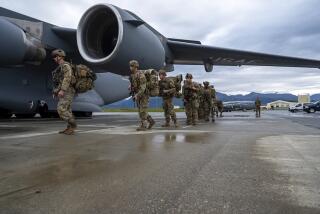Protesters Plan for S.D. Visit by Soviet Ships
- Share via
SAN DIEGO — Politically opposite groups, from Greenpeace to the John Birch Society, are honing strategies to protest a common enemy: three Soviet warships that will visit here later this month.
Some groups oppose the Soviet Union’s politics; others denounce its nuclear-capable vessels; still others believe it’s not appropriate for the two nations to meet. The Cold War may be over, the groups say, but there is still a battle to be fought.
The protests, like the groups, will vary in strength as well as approach. Officials with Greenpeace, an anti-nuclear environmental group, are considering gathering a flotilla of boats to draw attention to the presence of nuclear weapons in the harbor.
Others, such as the Baltic American Freedom League and the Lithuanian American Community, plan to send caravans of protesters from Los Angeles to San Diego to unfurl banners and stage rallies. Still others, like the John Birch Society, have waged war with paper--printing monographs warning against U.S.-Soviet exchanges.
The Soviet ships--the Admiral Vinogradov, the Boyevoy, and the Argun--will sail to San Diego July 31 for an unprecedented five-day visit to the West Coast. The Soviet visit is the second round in an exchange program established by Adm. William Crowe, former chairman of the U.S. Joint Chiefs of Staff, and Marshal Sergei Akhromeyev, former Soviet chief of staff.
Last July, the Soviet navy visited a U.S. naval base in Norfolk, Va. The following month, the U.S. Navy sailed to Sevastopol in the Crimea. This September, the reciprocity will continue as three U.S. ships sail to Vladivostok.
From July 31 to Aug. 4, Adm. Charles Larson, commander-in-chief of the U.S. Pacific Fleet, will host his Soviet counterpart, Adm. Gennadj Alexandrovich Khatov, commander of the Soviet Pacific Fleet.
The visit is meant to foster goodwill and understanding between the two nations, Navy officials say, but many organizations view the meeting of each navy’s top brass as presenting an ideal platform to grab attention for their causes.
“We try to stay in the forefront and try to get as much attention and focus as possible,” said Jurgis Joga, president of the Los Angeles chapter of the Lithuanian American Community, which opposes the Soviet Union’s actions in Lithuania.
“Because the fleet commanders for both countries are going to be meeting with one another, we think this is an opportunity to talk about nuclear disarmament,” said Karen Topakian, disarmament campaign coordinator with Greenpeace in San Francisco.
Navy officials will not comment on whether the Soviet vessels will have any nuclear weapons aboard. The Boyevoy is a guided-missile destroyer; the Admiral Vinograd is a destroyer designed for anti-submarine warfare that is outfitted with surface-to-air torpedoes that can carry either nuclear or conventional warheads. The third ship, the Argun, is an oiler, a support vessel.
In San Diego, the U.S. Navy harbors 14 nuclear-powered submarines and one nuclear-powered cruiser. But the Navy will neither confirm nor deny the presence of nuclear weapons, said Master Chief Petty Officer Mike McLellan, a Navy spokesman.
To safeguard the Soviet visitors, as well as protect against espionage, Navy officials will work with members of the Federal Bureau of Investigation, local police, Coast Guard and the Naval Investigative Service.
Officials said they are unhappy about the prospects of protesters but realize it is a constitutional right.
“This is a Soviet navy visit to the U.S. Navy. That puts the onus on the U.S. Navy as host to make the visit run as smoothly as possible,” said Cmdr. Doug Schamp, a Navy spokesman. “From that standpoint, it does concern us, though they have every right in the world to protest. It’s certainly one of the reasons we live here.”
Accordingly, several groups, from San Diego to San Francisco, will prepare to raise their voices in concern. And the responses could range from holding press conferences to buzzing the Soviet vessels.
“We don’t like our own Navy’s nuclear weapons in the harbor, and we don’t think the problem should be compounded by bringing weapons in from another country,” said Jim Jacobson, director of Alliance for Survival, which will work with the Peace Resource Center to show its disapproval of nuclear weaponry.
“It will compound the problem of possible accidents,” Jacobson said, “the more weapons there are, the more accidents there might be.”
Carol Jahnkow, director of the Peace Resource Center, said a military exchange is inappropriate because relations between the two nations have dramatically warmed.
“The changing political climate means we need to change our thinking,” Jahnkow said. “Military exchanges are old-guard thinking--I’d rather see positive civilian exchanges, like cultural exchanges.”
Not all groups, however, are certain what type of protest they will undertake. Some say they will probably take their cue from others.
“If there’s a demonstration, I would imagine the Ocean Beach Greens will join in,” said Kip Krueger of that environmental group.
Still others, like John Birch Society officials, say they object to the meeting itself, though they are uncertain what action they will take. “We believe it’s inappropriate,” said Gary Benoit, director of research for the society. “It’s part of a pattern on the part of the U.S. government to get American people thinking of the Soviet Union as an ally. The danger would be that the U.S. would sacrifice its sovereignty and no longer act as a nation but as one part of world government.”
More to Read
Sign up for Essential California
The most important California stories and recommendations in your inbox every morning.
You may occasionally receive promotional content from the Los Angeles Times.













